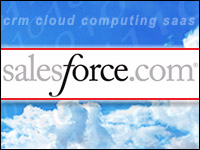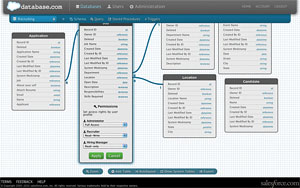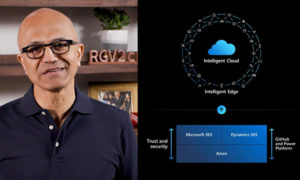
Salesforce.com on Tuesday unveiled Database.com, which it called the first enterprise database for the cloud.
This is “the exact same database technology” as Salesforce.com’s existing database but is “being packaged and provided as a standalone product so people can build platforms on their own technologies,” Ariel Kelman, a Salesforce vice president, told CRM Buyer.
It uses “a lot of Java, some open source technologies and some third-party software apps,” Kelman said.
The database is automatically scalable and has a high level of security, according to the company. It lets developers create software ranging in size from small mobile apps to large enterprise applications.
Databse.com also has a pre-built social data model.
Digging Down Into Database.com
Database.com has a relational data store that includes tables, relationships, support for a variety of field types, triggers and stored procedures, a query language and enterprise search.
It offers file storage for content in various formats, including video and images.
Developers can write Database.com apps in various languages, including Java, C# and Ruby. They can run these apps on any platform — Force.com, VMforce, Amazon EC2, Google AppEngine, Heroku or Microsoft Azure, Salesforce said. The apps can run natively on any mobile device such as Android phones, BlackBerry devices or iOS devices such as the iPad and iPhone.
All apps written by third-party developers will connect securely to Database.com over the Internet using REST and SOAP, application programming interfaces (APIs) for which are in the database.
“Database.com brings a number of advantages that enterprise developers will find compelling, similar to what we’ve seen more broadly with the rapid adoption of cloud computing and software as a service,” Juan Carlos Soto, a senior vice president at Informatica, told CRM Buyer.
“With Database as a Service, developers and independent software vendors can quickly deploy applications that require database access without having to set up hardware or software systems to host the database.”
Scaling for the World
Database.com can scale up easily, Salesforce.com said. It offers automatic tuning, upgrades, backups and replication to remote data centers, and it automatically creates sandboxes for development, testing and training.
“Now, very sophisticated enterprise apps people would previously have run on on-premise databases will be able to run on the cloud, and the scalability will be automatic,” Salesforce.com’s Kelman pointed out. “Client/server database software like Oracle or SQL Server can’t scale easily, but we scale the databases easily for you because we host them on our multitenant architecture,” he added.
However, it’s not likely that enterprises will swop out their legacy databases for Database.com instantaneously.
“Oracle, DB2, SQL Server and Sybase have a footprint in the industry that won’t go away overnight,” Jonathan Bruce, a senior product manager at Progress Software, told CRM Buyer. “I think Databse.com is highly complementary to the established databases of today.”
All data in Databse.com will be stored on Salesforce.com’s servers.
Keeping Data Safe
Access to data in Database.com can be managed through oAuth or SAML. Database.com provides user management features including identity and profiles as well as authentication.
Database.com also has point-and-click tools that let developers define data security access rules down to the row level.
“We can advance the move to the cloud by making this incredibly trusted and very well-vetted database available,” Kelman said. “We have most of the world’s largest banks, and security specialists like Cisco and Symantec, who use our servers, and they are constantly vetting our security.”
Making Things Social
Database.com also includes a pre-built social data model for feeds, user profiles, status updates and a following model for all database records. It comes with social APIs developers can use to interact with the social components of their data models.
Developers can specify who can follow database records or request data feeds. This will make it easier to control access to records, and will also make it easier to track information, in near real-time.
“I’m responsible for our product line so, a year ago when our Chatter app went live, I’d have to write down a list of opportunities,” Kelman said. “Now they get pushed to my feed. We’ve taken all that social functionality and embedded it in the database.”
The social features “essentially pop the top off the Chatter feature and let appdevs built their own Chatter-type functionalities,” Kelman said. They can integrate these into existing enterprise social networks such as those provided by IBM’s Lotus, if needed. operating systems direct cross-platform SQL-based access to Databse.com.
“You take our driver and get any app server you can think of — IBM WebSphere; Oracle WebLogic — and use Database.com as your primary database source,” Bruce said.
Informatica is demonstrating at Dreamforce 2010 an extension to its Informatica Cloud Service that enterprises to move data to and from database.com without having to port it or recompile code.
“This frees developers to focus on building new applications instead of managing a database infrastructure,” Informatica’s Carlos Soto pointed out.
























































Social CRM
See all Social CRM